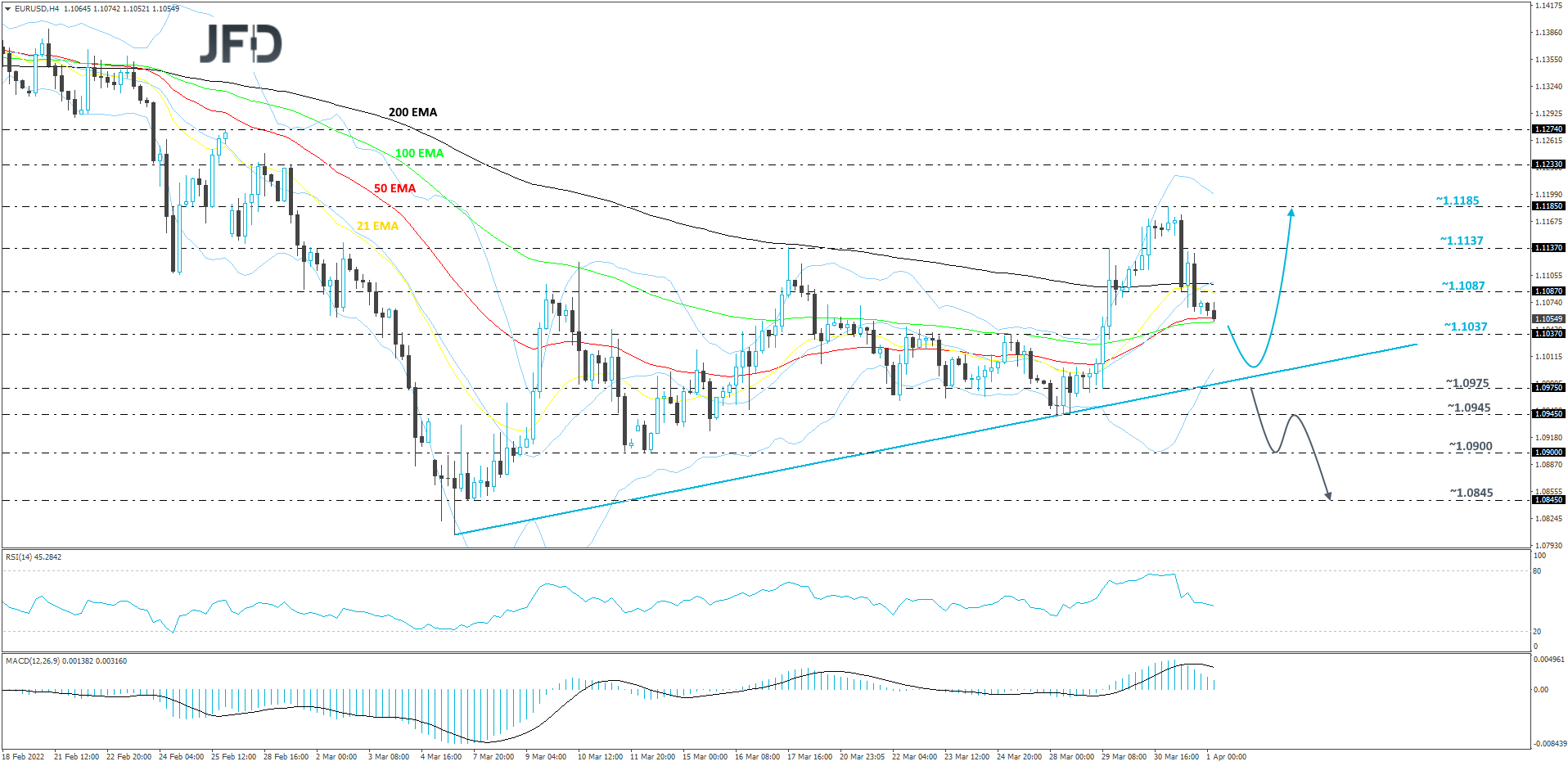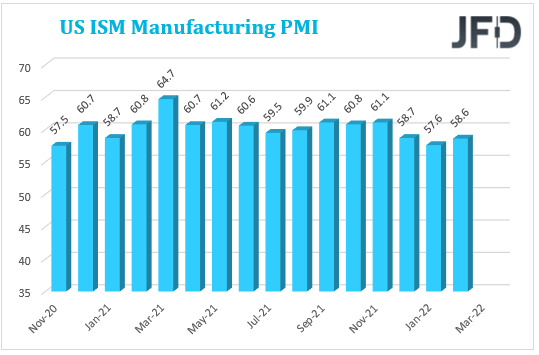We have an eventful day today in terms of economic data releases. During the early hours of the Asian morning, Japan delivered some of its Q1 Tankan manufacturing and non-manufacturing figures, which measure the general business conditions in those sectors. Manufacturing PMIs of various countries will be monitored carefully, together with the U.S. job numbers.
Japanese Data and Manufacturing PMIs From Around the World In Focus
Today, during the early hours of the Asian morning, Japan delivered some of its Q1 Tankan manufacturing and non-manufacturing figures, which measure the general business conditions in those sectors. The Tankan large manufacturers index was expected to fall slightly, going from 18 to 12; however, it came out at 14, managing to beat the forecast.
The reading was still on the lower side, compared to the previous one, which got adjusted to 17. The non-manufacturing one was forecasted to drop from 9 to 5 but showed up at 9, as the previous reading got adjusted to 10.
Japan also delivered its manufacturing PMI figure for March, which was able to beat both the previous 52.7 and the forecasted 53.2, coming out at 54.1. After the data came out, the Japanese yen did not react much, as it remains vulnerable to the broader market sentiment.
Australia produced the MoM home loans numbers, which showed up at -4.7%, well below the previous +1.0%. However, Australia’s manufacturing PMI number was a bit more positive than the home loans one. The PMI beat the previous 57.0 reading, together with the forecasted 57.3 number, coming out at 57.7.
China released the Caixin manufacturing PMI number for March, which was initially expected to move slightly to the downside. The forecast was set at 50.0, the previous reading was at 50.4, but the actual figure appeared at 48.1, which indicates a contraction in the manufacturing sector. The last time the figure was below was back in March 2020, when the February figure was released.
In the early hours of the European session, Switzerland took center stage as it delivered its MoM and YoY CPI numbers for March. The actual MoM reading came out at +0.6%, which is better than the initial forecast of +0.5% but worse than the previous +0.7% figure.
The YoY number met its forecast and came out at +2.4%. The Swiss National Bank’s price stability target is for the CPI numbers to be less than 2.0% per annum. The CHF remained unchanged after the Swiss data release against its major counterparts.
GBP/CHF – Technical Outlook
GBP/CHF continues to move lower while trading below a short-term tentative downside resistance line taken from the high of Mar. 23. In addition to that, the pair is still below all the EMAs on our 4-hour chart, which may also be seen as a bearish indication. We prefer to wait for a break below yesterday’s low first, which is at 1.2095, and then go for lower areas.
A break below that 1.2095 hurdle would confirm a forthcoming lower low, potentially attracting more buyers into the game. GBP/CHF may drift to the 1.2053 obstacle or the 1.1968 level. That level marks the low of Jan. 11, 2021.
To shift our attention to some higher areas, we would prefer to wait for a break above the aforementioned downside line and for a push above the 1.2203 barrier, marked by the high of Mar. 30. More buyers could jump in and drive the rate towards the 1.2292 hurdle, marked by the high of Mar. 29, where a temporary hold-up might occur.
If the bulls stay strong, they could overcome that hurdle and aim for the 1.2335 level, which is the high of Mar. 28.

Later on, we will get the final manufacturing PMI numbers from various individual European states and the eurozone. For example, the German figure is expected to have stayed the same, at 57.6, whereas the eurozone’s reading is forecasted to drop from 58.2 to 57.0.
The United Kingdom will also show its number for the same indicator. For now, it is expected to decline the most, going from 58.0 to 55.5.
U.S. Employment Data Takes Centre Stage
However, the main event on the economic calendar for most market participants will be the U.S. jobs numbers for March. Currently, the unemployment rate is forecasted to drop slightly, going from 3.8% to 3.7%. The nonfarm payrolls reading is expected to decline, going from 678k to 490k.
For the past two months, the number was able to beat its initial forecasts. However, economists are a bit more skeptical this time, as the current inflationary pressures are forcing some businesses to rebalance their books and slow down the recruitment of new workers.
Another important U.S. jobs number, which will get released, will be the average hourly earnings on an MoM and YoY basis. The current expectation is a decline in the MoM figure, going from +0.6% to +0.4%.
However, the YoY number is believed to have improved from +5.1% to +5.5%, which could mean that, although job creation might have slowed down a bit, the existing employees are demanding higher wages due to rapidly rising inflation.
Quickly rising inflation is a big concern for the Fed. It keeps a close eye on these indicators to determine its aggressiveness towards future rate hikes. According to the CME FedWatch tool, it is expected to have rates between +2.50% and +2.75%.
EUR/USD – Technical Outlook
After pushing above all of the EMAs on our 4-hour chart in the first half of this week, EUR/USD is now seen pushing lower. That said, the pair continues to trade above a short-term tentative upside line drawn from the low of Mar. 7. Even if the rate drifts a bit lower, we will continue aiming higher as long as it stays above that upside line.
If the pair rebounds from somewhere near the aforementioned upside line, EUR/USD could make its way back up again, possibly testing the 200 EMA, or the 1.1087 hurdle, marked by an intraday swing low of yesterday. If the buying doesn’t stop there, the next possible target might be at 1.1137, or at 1.1185, which is the current highest point of this week.
Alternatively, if the previously mentioned upside line breaks and the rate falls below the 1.0975 hurdle, marked by an intraday swing low of Mar. 29, that may signal a change in the direction of the current trend. EUR/USD may drift to the current low of this week, at 1.0945, a break of which might set the stage for a move to the 1.0900 zone, marked by the low of Mar. 14.
If the slide continues, the next potential target could be at 1.0845, marked by an intraday swing low of Mar. 7.

As For The Rest Of Today’s Events
In addition to the job numbers, the U.S. will release the ISM manufacturing PMI figure for March. That reading is expected to have improved slightly from 58.6 to 59.0.
